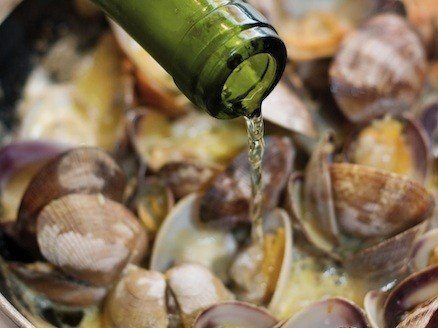A Chef's Tips For Cooking With Wine
Cooking with wine is nothing new — the ancient Romans used to liven up their dinners with a splash or two of defrutum, a special brew they used just for the occasion, and the very first cookbook we know of lists dishes that call for wine. But for some reason, when we come across a recipe that instructs us to deglaze the pan with a dry white, we are filled with trepidation.
Adding wine to your dinner isn't much more difficult than adding it to your favorite wine glass. And skipping the step could end up costing you the best parts of your meal —wine is added to impart flavor, add body, and bring out tastes in other ingredients. Without a dash of merlot, that tomato sauce won't taste as the chef intended.
By keeping a few simple tips in mind, you can flex your culinary muscles and enjoy the taste of your favorite beverage in your new favorite meal.
1. Aim for middle ground
We've all heard the adage to only cook with what you would drink, and there's some truth behind it: Cooking wine consolidates its flavor, so a poor wine will taste extra off when it's reduced in the pot. Then again, the most delicate nuances in fine wine are lost once put to heat, so don't waste a special vintage on a dish of short ribs.
"You won't catch me marinating flank steak in vintage Rioja Reserva!" agrees chef Jose Garces, owner of award-winning restaurants in Philadelphia and Chicago, and one of the culinary masterminds on the Food Network's Iron Chef America. "I have no qualms about using lower-quality wines for cooking, although for dishes where the flavor of the wine will be more apparent, such as light-flavored fish dishes, I prefer something a few steps up from the jug of cooking wine that I always keep in the kitchen."
2. Consider the other ingredients you are cooking with
Recipes often call for a "dry white" or a "medium-bodied red," but different wines will impart different flavors. Garces says to pick a wine that has the undertones you are already working with.
"Choosing a wine to cook with is a lot like choosing a wine to serve with a meal," he explains. "For lighter dishes, you want something more delicate, whereas for fuller-flavored plates, a bigger wine is important to stand up to the food. As a basic rule, I like to use dry, crisp whites when cooking seafood or risottos, and jammy, juicy reds for things like marinades on red meats."
You'll often find terms like "dry" or "crisp" right on the label, but examples of popular dry whites include sauvignon blanc and pinot grigio, while fruity reds that stand up to the cooking process include merlot and zinfandel.
3. Don't be afraid to think outside the box
If you think a dish needs more wine, then add it! Taste too strong? Cook a little longer to burn off the alcohol, or even out the taste with something sweet or fruity.
And if a favorite recipe doesn't call for wine but you think it could use some punching up, go for it. Garces says he's been known to use liquors and dessert wines in lieu of oil when cooking desserts, giving his sweet endings a special flair.
"I also love to work with sherry, a staple in Spanish cooking," he says. "Both dry and sweet sherries are great in sauces, and an aged sherry, such as Pedro Ximenez, is ideal for reductions and lends a sweet, nutty character to a demi-glace."
So stop at the store this weekend and try that recipe you've been staring at longingly from across the kitchen. "It will bring a new level of flavor and adds fruit and acid notes without overpowering other ingredients," says Garces. "Plus, it never hurts to enjoy a glass while you're preparing the meal — it makes the entire process a pleasure, from start to finish."
— Melissa Grenier, The Drink Nation
More From The Drink Nation:
How to Make the Perfect Margarita
